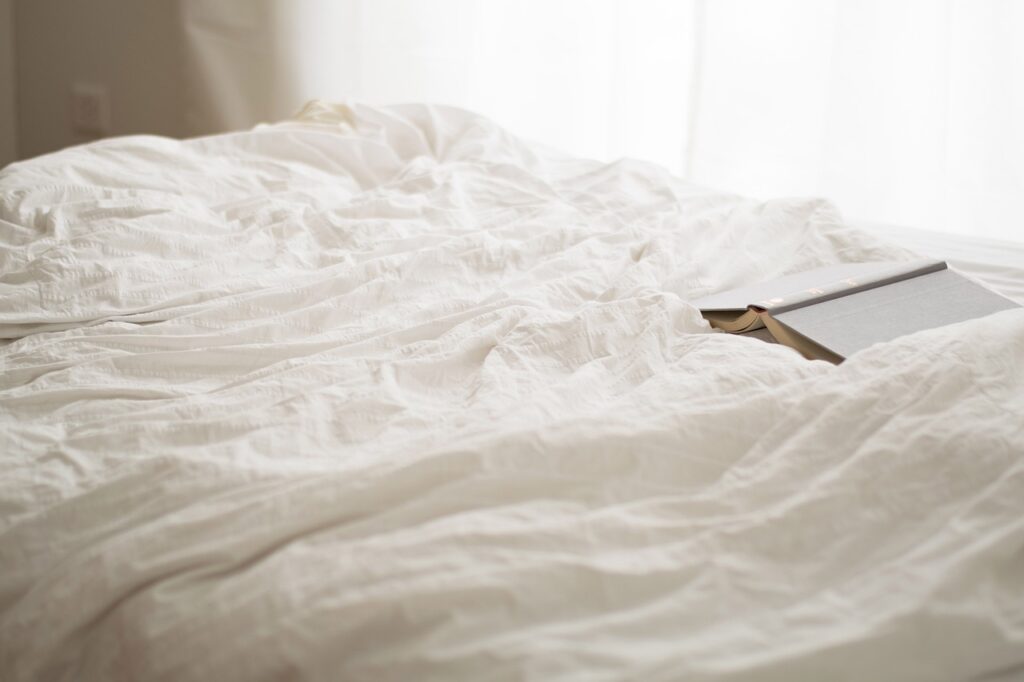You may not want to think about it, but bed bugs can be a real problem for many people. Though they don’t transmit disease, these tiny insects can cause itchy bites and make it difficult to sleep at night. The good news is that there are many bed bug prevention measures you can take to avoid an infestation in your home.
In this guide, we’ll explore the behavior and habits of bed bugs, how to inspect your home for signs of an infestation, and precautions to take when traveling. We’ll also cover how to treat infested furniture and clothing and how to work with professionals to eradicate bed bugs if needed.
By following these tips, you can help keep your home bed bug-free and enjoy a good night’s sleep.
Understanding Bed Bug Behavior and Habits
Understanding bed bug behavior and habits is crucial in keeping your home free from these pesky pests. Bed bugs are nocturnal and prefer to hide in cracks and crevices during the daytime. They are attracted to warmth and carbon dioxide, which is why they tend to infest areas where people sleep.
Bed bug feeding typically happens at night when their human hosts are asleep, and they can go for several months without feeding. They reproduce quickly, with females laying up to five eggs a day, and their eggs can hatch in as little as 10 days.
Identifying bed bug bites can be difficult, as they can look similar to other insect bites. To prevent bed bugs in multi-unit buildings, it’s important to maintain cleanliness and report any sightings to building management immediately.
Inspecting Your Home for Signs of Bed Bugs
Take a deep breath and prepare yourself, ’cause it’s time to roll up your sleeves and start inspecting your home for any unwelcome visitors.
The first step in preventing a bed bug infestation is to identify whether or not you already have one. Look for signs such as small bloodstains on your sheets, dark spots on your mattress and box spring, and a musty odor in your room.
Bed bugs are small and flat, so they can hide in tiny crevices such as the seams of your mattress or cracks in your walls. Be sure to check all areas of your bedroom thoroughly, including behind picture frames, in electrical outlets, and even in your clothes and luggage.
If you do find bed bugs, don’t panic. There are DIY prevention measures that you can take to help get rid of them. Start by washing all of your bedding in hot water and drying it on high heat. Vacuum your mattress, box spring, and surrounding areas thoroughly, and dispose of the vacuum bag in a sealed plastic bag.
Use a bed bug spray or powder to treat your mattress and box spring, and consider investing in bed bug-proof mattress and pillow covers. It’s also important to declutter your bedroom and seal any cracks or crevices in your walls or baseboards.
With a little bit of effort and persistence, you can successfully eliminate bed bugs from your home and prevent them from returning.
Taking Precautions When Traveling
As you embark on your next adventure, be sure to shield yourself from the pesky hitchhikers that could potentially disrupt your travels and haunt your dreams with their haunting symbolism of infestation.
One of the best ways to do this is to take necessary precautions when staying in hotels. Make sure to research the hotel’s reputation for cleanliness before making a reservation. Check online reviews and ratings from previous guests to ensure that the hotel has a good track record of maintaining high standards of hygiene.
Additionally, inspect your hotel room upon arrival for any signs of bed bugs, such as brownish-red stains on the sheets or mattress, small black dots on the bed frame or headboard, or a musty smell.
Another important step in preventing bed bugs during travel is to prepare your luggage properly. Keep your luggage off the floor and away from furniture, especially the bed or couch in your hotel room. Use luggage racks or place your suitcase in the bathroom, as bed bugs are less likely to be found in these areas.
You can also pack your clothes in sealed plastic bags or use bed bug-proof luggage encasements to prevent any unwanted hitchhikers from making their way into your belongings. By taking these simple precautions, you can ensure that your travels are bed bug-free and stress-free.

Treating Infested Furniture and Clothing
Now that you’ve unfortunately encountered these pesky critters, let’s talk about how to get rid of them from your furniture and clothing.
The first step is to isolate infested items by placing them in sealed plastic bags. This will prevent the bed bugs from spreading to other areas of your home.
Next, you’ll want to use cleaning techniques to eliminate the bugs. Vacuuming is a great way to remove bed bugs, but make sure to use a vacuum with a HEPA filter to prevent the bugs from escaping.
After vacuuming, you should wash all infested clothing and bedding in hot water. If an item can’t be washed, like a mattress, you can use a bed bug-proof encasement to trap the bugs inside.
If cleaning techniques aren’t enough, you may need to use pest control products. There are many different types of bed bug sprays and powders available, but be sure to read the label and follow the instructions carefully.
Using too much product can be dangerous, especially if you have pets or young children in the home. If you’re not comfortable using pest control products yourself, consider hiring a professional exterminator.
They can provide a more effective treatment and ensure that all bed bugs are eliminated from your home.
Working with Professionals to Eradicate Bed Bugs
If you want to sit back and let the experts handle the bed bug problem, consider hiring professional exterminators for a hassle-free solution. These professionals are equipped with the right tools and expertise to locate and eradicate bed bugs effectively.
They’ll inspect your home, identify the infested areas, and use the appropriate treatment method to eliminate bed bugs. Hiring professional exterminators ensures that the problem is resolved quickly and efficiently, saving you time and energy.
However, if you prefer to take a DIY approach, there are some methods you can try. Vacuuming your home regularly can help reduce the number of bed bugs in your home. Make sure to dispose of the vacuum bag or contents in a sealed plastic bag to prevent bed bugs from escaping.
You can also use heat treatment by washing your bedding, clothing, and other infested items in hot water and drying them on high heat. While DIY methods can be effective, they may not completely eradicate the bed bug infestation, and it may take more time and effort to achieve the desired results.
Frequently Asked Questions
How do bed bugs reproduce and how fast do they multiply?
Bed bug reproduction is a fast and efficient process. Female bed bugs can lay up to five eggs per day and can produce up to 500 eggs in their lifetime. The eggs take about 6-10 days to hatch and the nymphs can start feeding on a host immediately.
The nymphs will molt five times before reaching adulthood, which takes about 5-8 weeks. With these rates, a single female bed bug can quickly turn into a full-blown infestation in just a few months.
It’s important to address bed bug issues as soon as possible to prevent their rapid multiplication and spread.
Can bed bugs cause health problems to humans?
If you’ve ever encountered a bed bug infestation, you may be wondering whether these pesky insects pose any health risks to humans. The answer is yes, bed bugs can cause a variety of health problems, including skin rashes, allergic reactions, and psychological distress.
Symptoms of bed bug bites include red, itchy welts that may be grouped in a line or cluster. While bed bugs aren’t known to transmit disease, their bites can cause secondary infections if scratched excessively.
If you want to avoid these health risks, prevention measures are key. Regularly inspecting and cleaning your bedding, furniture, and luggage can help to reduce the likelihood of a bed bug infestation. If you do find bed bugs in your home, professional treatment may be necessary to fully eliminate the problem.
What is the lifespan of a bed bug and how long can they survive without a blood meal?
Feeling itchy and paranoid? You might be dealing with bed bugs! These pesky insects can survive without a blood meal for up to a year! That’s right, you read that correctly, a YEAR!
Not only that, but the lifespan of a bed bug can range from several months to a year or more. So, while you may think you have gotten rid of them, they could just be lying dormant, waiting for their next meal.
It’s important to act fast and take preventative measures to avoid a bed bug infestation.
Do bed bugs only live in beds or can they infest other areas of a home?
Bed bugs aren’t limited to just beds, they can infest other areas of a home. They can live in furniture, carpets, and even behind electrical outlets.
A bed bug infestation can be a nightmare, but there are pest control methods that can help get rid of them. Vacuuming regularly, washing bedding in hot water, and using bed bug encasements can all help prevent and control an infestation.
It’s also important to inspect second-hand furniture and belongings before bringing them into your home, as bed bugs can easily hitch a ride. Don’t let bed bugs take over your home, take action with these pest control methods.
How do bed bugs get into a home in the first place?
Bed bugs can easily find their way into your home through various sources. They can hitch a ride on your clothing, luggage, or even your pets. They can also infest second-hand furniture or items purchased from thrift stores.
To prevent bed bugs from entering your home, it’s important to inspect second-hand items before bringing them inside and to wash your clothes and bedding in hot water after traveling. Additionally, sealing cracks and crevices in your home and keeping clutter to a minimum can help eliminate potential hiding spots for bed bugs.
By taking these prevention measures, you can decrease the likelihood of a bed bug infestation in your home.
Conclusion
Congratulations! You’ve taken all the necessary steps to protect yourself and your home from bed bugs. You’ve learned about their habits and behavior, inspected your home, and taken precautions while traveling. You’ve even treated any infested furniture and clothing.
But, before you breathe a sigh of relief, there’s one more thing to consider. Bed bugs are resilient creatures and can easily hitch a ride into your home without you even realizing it. So, it’s important to remain vigilant and continue to inspect your home regularly.
Remember, prevention is key when it comes to bed bugs. By following these measures, you can rest easy knowing that you’ve done everything in your power to keep these pesky bugs at bay.


